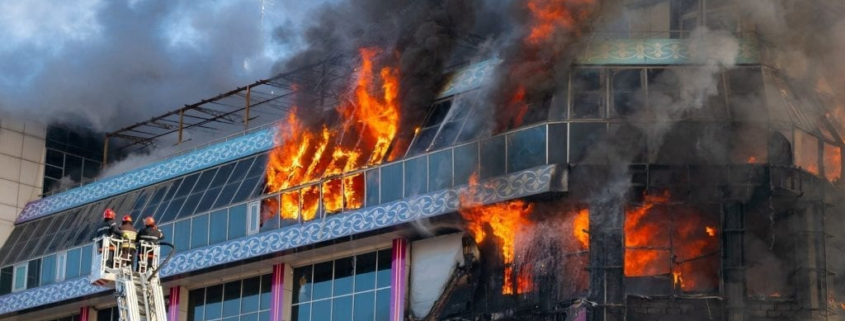Commercial Property Insights – The Importance of Fire Doors
The Importance of Fire Doors
If a fire occurs at a commercial property, time is of the essence to keep it under control. Therefore, having measures in place to slow the spread of the flames and minimize potential damages is crucial. That’s where fire doors can help. These doors are specifically designed to withstand the extreme heat of a fire for a period of time, temporarily blocking flames from traveling from one area of a building to another. Fire doors can make all the difference in allowing building occupants to escape the premises and preventing property damage.
However, National Fire Protection Association (NFPA) standards—namely, NFPA 80—emphasize that fire doors must be routinely inspected and adequately maintained in order to be effective. Review the following guidance to learn more about fire doors and best practices for keeping them fully operational.
How Fire Doors Work
A fire door is a specially designed, fire-resistant barrier constructed to serve as a heat shield and slow the spread of fire and smoke. In the event of a fire, they are engineered to close automatically. Fire doors are manufactured in accordance with specific regulations, including safety codes and standards outlined by the NFPA and the International Fire Code.
A fire door consists of multiple components, including the door, door frame, hinges, handle and additional hardware. Collectively, these parts are designed to withstand fire exposures for a set period of time, slowing the spread of flames and smoke throughout sections of the affected property.
Fire doors can vary in size, materials and layout (e.g., a swinging, sliding, hinged or rolling door). They are typically utilized within the wall openings and stairwells of buildings. Installing fire doors in wall openings can help keep flames from spreading on the same floor of a property; in stairwells, these doors can deter a fire from traveling between stories of a property and may allow additional building occupants to escape safely via the stairs. Fire doors can also provide firefighters with better access to the property overall, bolstering fire suppression efforts.
Some fire doors must stay fully closed to work. Otherwise, flames and smoke will easily travel through any openings, defeating the purpose of the doors.
Other fire doors are equipped with fusible links—heat-activated devices designed to ensure that such doors adequately close in the presence of fire—do not need to stay shut at all times. In these circumstances, the doors can be kept open as long as there are no obstructions (e.g., a door wedge) in the way that could potentially prevent them from closing when necessary. Most rolling fire doors are equipped with fusible links.
Each fire door is designed to meet the standards of its resistance rating, which represents how long the door can withstand fire exposures before eventually succumbing to the heat and smoke. This rating is determined through various testing procedures and applies not only to the door but also to its collective parts. Fire door resistance ratings can range between 20 minutes and three hours. For example, if the door can withstand fire exposures for one hour, then it will be rated as a one-hour fire door. The NFPA has different fire ratings for doors that business owners should be aware of.
Fire doors are taken into consideration when establishing a property’s fire divisions. Fire divisions are when there is enough fire prevention methods in place to prevent a fire from spreading from one part of a building to other parts of the building. While some buildings only consist of a single fire division, a property may contain multiple fire divisions if there are measures in place to limit a fire from reaching different areas of the building—such as a fire door. Properties with approved fire divisions by way of fire doors may benefit from reduced commercial insurance rates, seeing as there is a lower risk of a fire spreading across the entirety of the building. On the other hand, properties that remove or don’t incorporate fire doors and thus lack multiple fire divisions may encounter higher commercial insurance rates since a fire is increasingly likely to affect the entire building and result in more severe damages.
Business owners should be aware that legal mandates necessitate the installation of fire doors in designated areas within commercial buildings. Although the precise locations requiring fire doors vary by state and city, certain areas such as stairwells, public corridors and hallways consistently require the presence of these protective barriers.
Maintaining Fire Doors
Fire doors can offer numerous advantages to a property; however, they must be properly maintained to remain effective. The NFPA outlines the following installation, inspection and maintenance requirements:
Ensure all fire doors at the property contain a fire label and resistance rating from trusted safety certification organizations FM Global, Underwriter Laboratories or Warnock Hersey (Intertek).
Only allow a competent, qualified contractor to install fire doors or modify existing ones. Modifying a fire door with the wrong components or hardware could make the door ineffective and lose its resistance rating. Also, contractors should be consulted about the possibility of equipping fire doors with fusible links.
Regularly inspect fire doors for potential damages (e.g., large gaps, broken seals, loose hinges or missing screws). Further, each door should connect firmly to its latch without getting stuck on the frame before fully closing. Repairs must be scheduled when necessary.
Have a certified professional conduct a visual inspection and—in the case of rolling doors—a drop test (a test that confirms the door works as it should and completely closes) on the property’s fire doors at least once every year. Based on the results, schedule repairs and make door replacements as needed.
Additionally, many insurance providers require annual fire safety inspections, which may include tests like fire door drop testing. Regular fire door inspections are crucial for ensuring both safety and adherence to fire and building codes.
For more risk management guidance, contact us today.
This Commercial Property Insights is intended as general information. The information contained in this article is not exhaustive nor should it be construed as legal advice. Readers should contact legal counsel or a licensed insurance professional for tailored guidance. © 2024 Zywave, Inc. All rights reserved.







Leave a Reply
Want to join the discussion?Feel free to contribute!